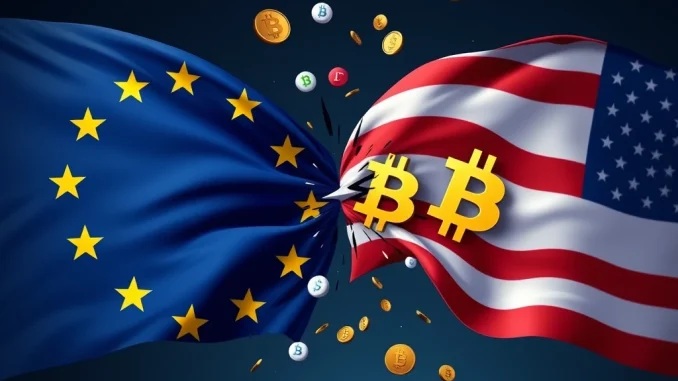
The cryptocurrency world is buzzing with a fresh alert from across the Atlantic! European Union regulators are raising eyebrows and sounding alarms about the United States’ approach to crypto. Why are they concerned, and what could this mean for the future of digital assets? Let’s dive into the details of this critical development and understand the potential ripple effects in the crypto sphere.
EU Regulators Flag Crypto Policy Risks from the U.S.
In a recent joint report, key European regulatory bodies – the European Securities and Markets Authority (ESMA), the European Banking Authority (EBA), and the European Insurance and Occupational Pensions Authority (EIOPA) – have collectively voiced their concerns. They believe the U.S.’s relatively accommodating stance towards cryptocurrencies could inadvertently amplify risks within the global financial system. This apprehension stems from the increasing integration of the crypto market with traditional financial institutions.
Here’s a breakdown of the key points from the EU regulators’ warning:
- Deepening Ties: The core worry is the growing interconnectedness between the crypto world and traditional finance. As more institutional investors and established financial players dip their toes into crypto, any turbulence in the crypto market could spill over into the broader economy.
- Volatility Concerns: Crypto assets are notorious for their price swings. The regulators emphasize the volatile nature of crypto valuations as a significant risk factor. Dramatic price drops can have cascading effects, especially when linked to traditional financial instruments.
- Institutional Adoption: Increased institutional adoption, while seen as a sign of crypto’s growing maturity, is also flagged as a potential hazard. Larger institutional involvement means bigger potential losses and wider impact if things go south.

The Spectre of Financial Market Risk
The EU regulators’ report isn’t just theoretical musing. It’s a direct response to the observed trends in the crypto landscape. The report highlights that the more intertwined crypto becomes with mainstream finance, the greater the potential for systemic financial market risk. Imagine a scenario where a major U.S.-based financial institution heavily invested in crypto faces significant losses due to a market crash. This could trigger a domino effect, impacting other financial sectors and potentially destabilizing the wider economy. This is precisely the kind of contagion risk European regulators are keen to avoid.
To put it simply, their message is: “The U.S. approach, while potentially fostering crypto innovation, needs a closer look to ensure it doesn’t inadvertently create new vulnerabilities in the global financial architecture.”
ECB’s Call for a Digital Euro Amid Crypto Policy Risks
Adding weight to these concerns, European Central Bank (ECB) board member Piero Cipollone has also voiced his opinion. Speaking to CoinDesk, Cipollone strongly advocated for the development and adoption of a digital euro. His rationale is partly driven by the perceived risks associated with the current crypto environment, especially those stemming from the U.S. crypto policy landscape.
Cipollone’s argument boils down to these key points:
- Speculative Nature of Crypto: He emphasized the inherently speculative nature of cryptocurrencies. Unlike traditional currencies backed by central banks, crypto values are often driven by market sentiment and technological hype, making them prone to bubbles and busts.
- Stablecoin Concerns: He specifically pointed to the risks posed by U.S.-backed stablecoins. Stablecoins, designed to maintain a stable value (often pegged to the US dollar), are increasingly used in crypto transactions. However, their reserves and regulatory oversight are areas of ongoing debate and concern. Cipollone seems wary of the potential dominance of U.S.-backed stablecoins in the European financial system.
- Digital Euro as a Counterbalance: The digital euro, in this context, is presented as a safer, more stable alternative to speculative cryptocurrencies and potentially risky stablecoins. It would be a central bank digital currency (CBDC), backed by the Eurosystem, offering a digital form of sovereign currency within the Eurozone.
Essentially, the ECB’s push for a digital euro is partly a strategic move to maintain monetary sovereignty and financial stability in the face of evolving global crypto dynamics and perceived crypto policy risks originating from the U.S.
What Does This Mean for the Future of Crypto Regulation?
The EU regulators’ warning and the ECB’s stance are significant because they highlight a growing divergence in regulatory approaches to crypto between major global economies. While the U.S. has been perceived as leaning towards fostering crypto innovation, Europe appears to be prioritizing financial stability and consumer protection, potentially taking a more cautious and restrictive path.
Here are some potential implications of this transatlantic regulatory divide:
- Regulatory Fragmentation: Different regulatory regimes in the U.S. and Europe could lead to fragmentation in the global crypto market. Crypto companies might face challenges navigating varying compliance requirements across jurisdictions.
- Innovation Hubs: The regulatory environment could influence where crypto innovation thrives. Stricter regulations in Europe might push some crypto businesses and talent towards more crypto-friendly jurisdictions, potentially including the U.S. (paradoxically, despite the EU concerns).
- Global Standards: The differing approaches could spur discussions and negotiations towards establishing more harmonized global standards for crypto regulation. International bodies may play a crucial role in bridging the gap and fostering a more coordinated approach.
Navigating the Shifting Sands of Crypto Regulation
For crypto investors, businesses, and enthusiasts, the EU’s warning serves as a crucial reminder of the evolving regulatory landscape. It underscores the fact that crypto regulation is far from settled and is likely to remain a dynamic and influential factor in the industry’s development. Keeping abreast of these global regulatory shifts is essential for anyone involved in the crypto space.
Here are some actionable insights to consider:
- Stay Informed: Continuously monitor regulatory developments in both the U.S., Europe, and globally. Regulatory news and reports from bodies like ESMA, EBA, EIOPA, and central banks are valuable resources.
- Risk Management: Be mindful of the potential for increased regulatory scrutiny and its impact on crypto markets. Diversification and prudent risk management strategies are more important than ever.
- Engage in Dialogue: Participate in discussions and consultations related to crypto regulation. Industry feedback and engagement can help shape more balanced and effective regulatory frameworks.
Conclusion: A Cautious Stance on Crypto Policy
The EU regulators’ warning about U.S. crypto policy risks is a significant development in the ongoing global conversation about digital asset regulation. It reflects a more cautious and stability-focused approach compared to the perceived U.S. stance. As the crypto industry matures and its ties with traditional finance deepen, these regulatory divergences and concerns will likely intensify. The path forward will require careful consideration, international cooperation, and a balanced approach that fosters innovation while safeguarding financial stability. The coming years will be critical in shaping the regulatory future of crypto and its role in the global financial system.



